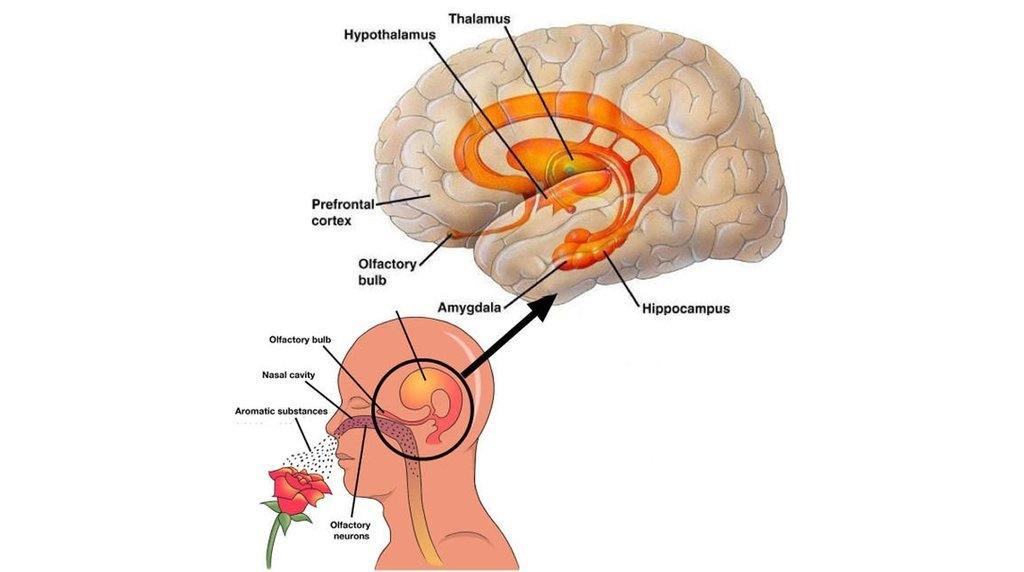অ্যারোমাথেরাপি কি এবং এটি কিভাবে কাজ করে?


অ্যারোমাথেরাপিকে ওষুধের একটি পরিপূরক শৃঙ্খলা হিসাবে সর্বোত্তম সংজ্ঞায়িত করা হয় যার লক্ষ্য নিরাময় এজেন্ট হিসাবে অপরিহার্য তেল ব্যবহার করে সামগ্রিক সুস্থতা প্রদানের দিকে। অ্যারোমাথেরাপি কীভাবে কাজ করে তা একটি রহস্য নয় বরং একটি বিশুদ্ধ বিজ্ঞান। অপরিহার্য তেল , অ্যারোমাথেরাপির নিরাময়কারী এজেন্ট 3টি ভিন্ন পথের মাধ্যমে শরীরে কাজ করে। যদিও এই পথগুলিকে প্রায়শই স্বতন্ত্র প্রক্রিয়া হিসাবে বর্ণনা করা হয়, বাস্তবে, প্রতিটি পথ যোগাযোগের পাশাপাশি শরীরের অন্যদেরকে প্রভাবিত করে।
প্রয়োজনীয় তেলের পথ - কীভাবে অ্যারোমাথেরাপি শরীরে কাজ করে
- ত্বকের পথ - ত্বকের মধ্য দিয়ে
- শ্বাস প্রশ্বাসের পথ - ফুসফুসের ঝিল্লির মধ্য দিয়ে
- ঘ্রাণপথ - নিউরো-এন্ডোক্রাইন সিস্টেমের মাধ্যমে
উপরের 3টি ছাড়াও, মৌখিক পথও রয়েছে, যেখানে সুগন্ধযুক্ত ওষুধ ব্যবহার করা হয়। একবার তেলগুলি শরীরের মধ্যে হয়ে গেলে তারা নিরাময় এবং সুস্থতা প্রদানের জন্য স্থানীয়ভাবে পাশাপাশি পদ্ধতিগতভাবে কাজ করে।

উপরের ফ্লো ডায়াগ্রামটি তিনটি ভিন্ন পথের মাধ্যমে কীভাবে প্রয়োজনীয় তেলগুলি শরীরে কাজ করে তার একটি সরলীকৃত নকশা চিত্রিত করে। অপরিহার্য তেল তরল বা বাষ্প হিসাবে গ্রহণ করা যেতে পারে। তরল ফর্মটি ত্বকে ম্যাসেজ করা যেতে পারে বা মৌখিকভাবে নেওয়া যেতে পারে। যেখানে, বাষ্প ফর্ম শ্বাস নিতে হবে.
ডার্মাল প্রয়োগে, তেল সরাসরি পেশী এবং টিস্যুতে পৌঁছায় যেখানে এটি প্রয়োগ করা হয়, সেখান থেকে এটি জয়েন্টগুলিতে পৌঁছায়। পেশী এবং টিস্যু থেকে সক্রিয় অপরিহার্য তেলের অণুগুলি রক্ত প্রবাহে এবং শরীরের অন্যান্য টিস্যু এবং অঙ্গগুলিতে যায়। অবশেষে, তারা মলত্যাগের অঙ্গগুলির মাধ্যমে নির্গত হয়। মৌখিকভাবে নেওয়া হলে, তেলের অণুগুলি অন্ত্রে যায় এবং সেখান থেকে রক্ত প্রবাহে যায়। অবশেষে, তারা নির্গত হয়।
প্রয়োজনীয় তেল শ্বাস নেওয়ার ক্ষেত্রে, তেলের অণুগুলি ফুসফুসের পাশাপাশি নাকের মধ্যে উপস্থিত ঘ্রাণশক্তিতে পৌঁছায়। ফুসফুস থেকে, অণুগুলি রক্ত প্রবাহে যায় এবং তারপরে ত্বক, কিডনি এবং ফুসফুসের মাধ্যমে নির্গত হওয়ার আগে শরীরের টিস্যু এবং অঙ্গগুলিতে যায়। অপরিহার্য তেলগুলি নাকের মাধ্যমে ঘ্রাণ ব্যবস্থায় পৌঁছানোর পরে, মস্তিষ্কের উপর প্রভাব ফেলে যার ফলে শক্তিশালী ইতিবাচক মানসিক ও মানসিক প্রভাব সহ রাসায়নিকগুলি মুক্তি পায়।
এই ক্ষেত্রেও, তেলের অণুগুলি একই পথ অনুসরণ করে ত্বক, কিডনি এবং ফুসফুসের মাধ্যমে নির্গত হয়। অ্যারোমাথেরাপি শরীরের পাশাপাশি মস্তিষ্কের উপর কীভাবে কাজ করে তা গভীরভাবে বোঝার জন্য এখন আসুন তিনটি পথের প্রতিটির বিশদ বিবরণ দেখি।
অপরিহার্য তেলের ত্বকের পথ

ত্বকে ম্যাসেজ করা অপরিহার্য তেল প্রয়োগের একটি আদর্শ উপায় হিসাবে বিবেচিত হয়। ত্বক বেছে বেছে-ভেদ্য প্রকৃতির এবং এটি প্রয়োজনীয় এবং উদ্ভিজ্জ তেল সহ জল এবং লিপিড ভিত্তিক পদার্থগুলিকে প্রবেশ করতে দেয়। অপরিহার্য তেলের ছোট আকারের অণু এবং তাদের জৈব সক্রিয়তা এপিডার্মিসে অনুপ্রবেশ সমর্থন করে।
ডার্মিসের কোষ এবং আন্তঃকোষীয় স্থানগুলির মধ্য দিয়ে ভ্রমণ করার পরে তারা অবশেষে লিম্ফ্যাটিক এবং রক্ত সঞ্চালন ব্যবস্থায় প্রবেশ করে। সেখান থেকে রক্তসহ সারা শরীরে নিয়ে যাওয়া হয়। লিপিডে দ্রবণীয় হওয়ার কারণে এই অণুগুলি এমনকি রক্ত-মস্তিষ্কের বাধা অতিক্রম করতে সক্ষম হয় এবং এইভাবে প্রয়োজনীয় তেলগুলি দ্রুত মস্তিষ্ককে প্রভাবিত করে ।
শোষিত অপরিহার্য তেলের অণুগুলির একটি ভাল অংশ রক্ত সঞ্চালন ব্যবস্থার সাথে যোগ করে, কিছু অংশ সিবাম এবং চুলের শ্যাফ্ট দ্বারা শোষিত হয়, যেখান থেকে তারা ত্বকের স্থানীয় মাইক্রোসার্কুলেশনে প্রবেশ করে। মৌখিকভাবে নেওয়া ওষুধের বিপরীতে, ত্বকের মাধ্যমে শরীরে প্রবেশ করা অপরিহার্য তেলগুলিকে যকৃতের মধ্য দিয়ে যেতে হবে না, যেখানে সেগুলি ব্যাপকভাবে পরিবর্তিত হতে পারে।
ত্বকে প্রয়োগের পরে, প্রয়োজনীয় তেলের অণুগুলি সরাসরি ধমনী সঞ্চালনে এবং সেখান থেকে তাদের আসল অবস্থায় পুরো শরীরে প্রেরণ করা হয়। অবশেষে, এই অণুগুলি শিরাস্থ সঞ্চালনে প্রবেশ করে এবং কিডনি-প্রস্রাব পথের পাশাপাশি ফুসফুস এবং ত্বকের মাধ্যমে নির্গত হয়।
অপরিহার্য তেলের শ্বাসযন্ত্রের পথ

শ্বাস নেওয়ার সময়, প্রয়োজনীয় তেলের ছোট অণুগুলি বাতাসের সাথে ব্রঙ্কিয়াল টিউবে নেওয়া হয়। সেখানে তারা শ্বাসনালী নিঃসরণকে উদ্দীপিত করে যা স্থানীয়ভাবে একটি আর্দ্রতার প্রভাব দেয়। আর্দ্রতা সমৃদ্ধ পরিবেশ অক্সিজেনের ভাল শোষণকে সহজ করে এবং ফুসফুস, গলা বা নাকের সংক্রমণের ক্ষেত্রেও উপকারী।
ব্রঙ্কিয়াল টিউবগুলিতে পৌঁছানোর পরে প্রয়োজনীয় তেলের অণুগুলি শ্লেষ্মা ঝিল্লিতে প্রবেশ করে এবং তাদের থেরাপিউটিক বৈশিষ্ট্য অনুসারে স্থানীয় টিস্যুগুলিকে প্রভাবিত করে। উদাহরণস্বরূপ, অ্যান্টিস্পাসমোডিক বৈশিষ্ট্য সহ প্রয়োজনীয় তেলের শ্বাস-প্রশ্বাসের ক্ষেত্রে, অণুগুলি মসৃণ পেশীগুলিকে প্রভাবিত করে, এইভাবে অতিরিক্ত শ্বাসনালী সংকোচনে সহায়তা করে।
ফুসফুসে পৌঁছানোর পরে, অপরিহার্য তেলের অণুগুলি গ্যাসীয় এবং সেইসাথে রক্ত এবং ফুসফুসের কোষগুলির মধ্যে পুষ্টি বিনিময়কে সহজ করে এবং ফুসফুস থেকে বর্জ্য নির্মূল করতে সহায়তা করে। পরবর্তী ধাপে, এই অণুগুলি রক্তে শোষিত হয় এবং ধমনী সঞ্চালনের সাথে সারা শরীরে সঞ্চালিত হয়। অবশেষে, শিরাস্থ সঞ্চালনের মাধ্যমে অণুগুলিকে মলত্যাগের অঙ্গগুলিতে ফিরিয়ে নেওয়া হয় যেখান থেকে সেগুলি প্রস্রাব, ঘাম এবং শ্বাসের মাধ্যমে নির্মূল করা হয়।
অপরিহার্য তেলের ঘ্রাণ পথ

মস্তিষ্কে অ্যারোমাথেরাপি কীভাবে কাজ করে তা একটি জটিল এবং গুরুত্বপূর্ণ বিষয় যা সাম্প্রতিক সময়ে অনেক আগ্রহ অর্জন করেছে। নাকে ঘ্রাণজনিত নার্ভ রিসেপ্টর (সিলিয়া) এবং প্রায় 20 মিলিয়ন স্নায়ু কোষ রয়েছে। প্রয়োজনীয় তেলগুলি শ্বাস নেওয়ার সাথে সাথে, ছোট অণুগুলি নাকের শ্লেষ্মা ঝিল্লির মধ্য দিয়ে যায় এবং স্নায়ু রিসেপ্টরগুলিকে উদ্দীপিত করে। এর ফলে একটি ইলেক্ট্রোকেমিক্যাল ইমপালসে পরিণত হয় যা নাসারন্ধ্রের শীর্ষে উপস্থিত ঘ্রাণযুক্ত বাল্বগুলিতে প্রেরণ করা হয়।

নাসারন্ধ্রে উপস্থিত ঘ্রাণীয় কোষগুলিকে প্রথম ক্র্যানিয়াল স্নায়ুর সম্প্রসারণ বলে মনে করা হয় যা ঘ্রাণতন্ত্রের মাধ্যমে গন্ধের উদ্দীপনা বহন করে যা মস্তিষ্কের বিভিন্ন স্থানে প্রবাহিত হয়। ঘ্রাণতন্ত্র তার পালাক্রমে অ্যামিগডালা এবং হাইপোথ্যালামাস, লিম্বিক সিস্টেমের অংশগুলিকে উদ্দীপিত করে।
হাইপোথ্যালামাস কেন্দ্রীয় স্নায়ুতন্ত্র, এন্ডোক্রাইন সিস্টেমের পাশাপাশি শরীরের কোষগুলির মধ্যে তথ্য বিনিময়ের নেটওয়ার্ককে প্রভাবিত করে। লিম্বিক সিস্টেমের যেকোনো উদ্দীপনা সেরিব্রাম (কর্টেক্স) এর পাশাপাশি সেরিবেলাম এবং তাদের কাজকেও প্রভাবিত করে। হাইপোথ্যালামাস থ্যালামাসকে প্রভাবিত করে। থ্যালামাস আবেগ এবং স্মৃতির সাথে সম্পর্কিত। হাইপোথ্যালামাস নিয়ন্ত্রণকারী কারণগুলির মাধ্যমে পিটুইটারি গ্রন্থিকেও প্রভাবিত করে।
অপরিহার্য তেলগুলি ঘ্রাণের মাধ্যমে শরীরকে প্রভাবিত করে । অ্যারোমাথেরাপি মস্তিষ্কে কাজ করে এবং কেন্দ্রীয় স্নায়ুতন্ত্রকে প্রভাবিত করে। অপরিহার্য তেলের প্রভাব লিম্বিক সিস্টেম এবং পেপটাইড-সেল রিসেপ্টর নেটওয়ার্ক থেকে এন্ডোরফিন নিঃসরণকে ট্রিগার করে, আনন্দের অনুভূতি বা সুস্থতার অনুভূতি প্রচার করে।